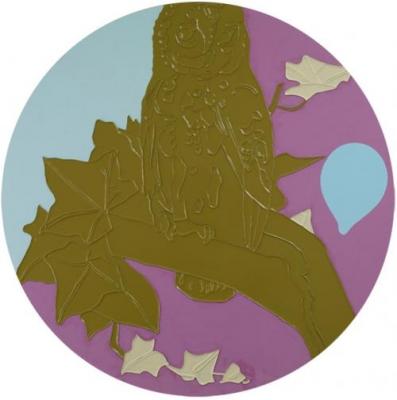Gary Hume: The Indifferent Owl @ White Cube – REVIEW
The White Cube (Mason’s Yard and Hoxton Square) presents us with an exhibition of new works by Gary Hume – an artist ever-faithful to his trademark high-gloss lacquer paint on aluminum, and with a deepening interest in sculpture.
Hume made his name, alongside the other YBAs, with his ‘Door Paintings’ being prominently featured in the ‘Freeze’ exhibition, and in Charles Saatchi’s ‘Sensation’. These simplified representations of hospital doors established the use of commercial gloss paint, along with a detached and clinical approach towards the subject matter, as the cornerstones of Hume’s practice. And not much has changed, with the inspiration for Hume’s new collection of work being the epiphany of indifference experienced upon finding a deflated party balloon near to where he had heard the hoot of an owl: ‘I imagined the owl, utterly indifferent, watching the balloon float by as it slowly collapsed’; ‘That’s how I see life. I’m the owl, totally disengaged as the balloon bobs by’.
For Hume, the balloon represents anything from current affairs, global warming, foreign wars etc – all of which he is determinably indifferent to. This feeling of detachment translates into all his pieces in that they have nothing to say about the wider human condition, or even point to any deeper meaning. In pride of place in the Mason’s Yard gallery, then, is the Indifferent Owl itself, the bird dispassionately surveying the flitting female figures, plant forms and birds depicted in the rest of the exhibition.
The natural curves and shapes of his organic subject matter fits well with Hume’s painting technique, with the raised edges between each applied colour (created using strips of draught excluder) resembling the edges of petals or leaves of some intricate plant. Equally, Hume’s new limestone sculptures are beautifully-textured and skillfully sanded-down phallic forms resembling the buds of flowers, or open-mouthed chicks. Eyes on either side of the ‘bud’ are directed towards his other works in the gallery – the red, fleshy pink, and mint green ‘Paradise’ paintings addressing themes of innocence while being vaguely suggestive. Like a ‘Magic-eye’ picture, you have to know what you’re looking for to see it: once you’ve made up your mind, however, it’s very hard to see anything else! Try to look at the fleshy pink areas as tops of thighs…
Over in the Hoxton gallery – though there is a solitary bud/baby bird separated from its flock and looking rather forlorn on the ground floor – the viewer is free from having every move followed by the eyes of owls or flower buds. Instead, the smaller first floor room is filled with 8 brightly painted aluminum arcs, placed unconventionally higher up the wall (all of Hume’s works are hung by his wife, the artist Georgie Hopton), thereby forcing the viewer to become the centre of the exuberant rainbow dance above them. Also in this room is a beautifully executed charcoal sketch of hyacinths, presented behind perspex. Of course, being a work by Hume, there is the obligatory addition of a few dots of commercial gloss paint applied on top of the perspex at the centre of each of the flowers.
On the ground floor, colossal aluminum sheets make up the work Playground – creating a black mirror surface, interrupted by schizophrenic poles and curves as in a climbing frame, and twice dotted with white, possibly in reference to the circular eyes of his baby birds. Six Poles – a work reminiscent of Henry Darger’s depictions of girls and seeming to reference girlish plaits – is brightly glossed in primary colours: there is a sense here of a children’s painting by numbers creation, which, together with Hume’s birds and flowers, points to a fascination with the stuff of childhood. There are however more subtle works around the room which give the eye a rest from the extreme amalgamations of colours elsewhere. But as this extreme is where Hume is at his most comfortable, his large glossy works remain – as when he first gained recognition – the artist at his most impressive. The loud bravura of these works, however, presents us with an irreconcilable irony in the practice of someone who wishes to be, like his owl, indifferent. Words Alice Lubbock © 2011 ArtLyst
Follow ArtLyst on Twitter for breaking art news and latest exhibition reviews

